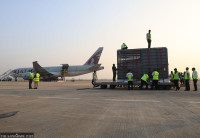Lumbini Province
Ruins of Maurya-era wall unearthed in Tilaurakot, Kapilvastu
The recent finding is crucial to help enlist Tilaurakot in UNESCO’s world heritage list.
Manoj Paudel
Ruins of a wall built during the Mauryan empire have been recovered during an excavation in Tilaurakot, Kapilvastu. Maurya era bricks measuring 47 cm long, 26 to 28 cm wide and 7 cm thick were used to build the wall.
According to archeologists involved in the excavation, the findings of the wall ruins have archaeological significance.
“The wall with nine-ten layers of bricks has been recovered in the middle of Tilaurakot. Additional information will certainly be discovered when it is unearthed to the natural soil level,” said Himal Uprety, archaeological officer of Lumbini Development Trust.
The Department of Archaeology and Lumbini Development Trust started excavating and exploring Tilaurakot, an ancient Shakya capital city where Siddhartha Gautam spent his princely life before he became the Buddha, and its surrounding areas in 2012.
A geophysical survey of the Tilaurakot premises conducted in 2014 showed a 30m long, 30m wide structure in the sunken land and a wall around it. The geophysical survey revealed an empty space in the middle which is believed to be a pond. The fresh excavation found the walls encircling the pond.
During an excavation in 2016/17, archaeologists had discovered the south-west and the south-east corners of the pond. The fresh finding of the wall ruins has been linked to those two corners, said archeologists involved in the excavation.
A group of archaeologists from the Department of Archaeology and the Lumbini Development Trust unearthed the area for about a month by using modern technology. A one metre wide, one-and-a-half metres deep and 24 metres long trench was dug during the excavation. Some earthen pots, copper coins and statues of animals were found during the excavation.
Various structures and goods from around 2,400 years ago, which was confirmed by carbon dating, were recovered at different times during the excavations.
“Such findings justify the historical evidence of Tilaurakot. The fresh excavation was conducted as per the geophysical survey,” said Bhaskar Gyawali, an officer at the Department of Archaeology.
The recent excavations, according to archaeologists, have been very crucial as they are helpful in the process of enlisting Tilaurakot in UNESCO’s world heritage list. The government plans to include Tilaurakot in the world heritage list.




 6.12°C Kathmandu
6.12°C Kathmandu












%20(1).jpg&w=300&height=200)

